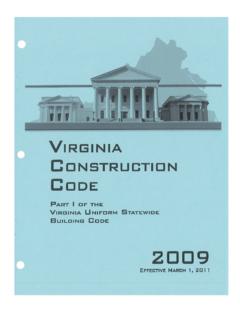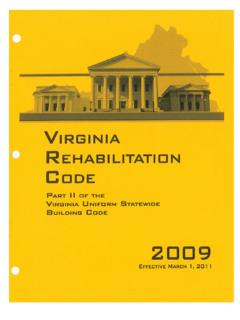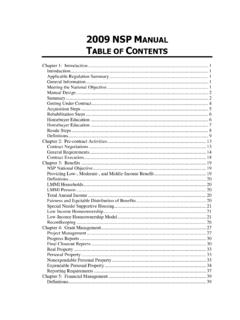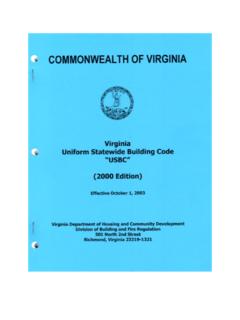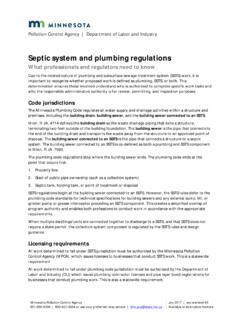Transcription of CARPORTS, GARAGES AND SHEDS VIRGINIA RESIDENTIAL …
1 Created Sept. 28, 2020 USBC 2015 Edition CARPORTS, GARAGES AND SHEDS VIRGINIA RESIDENTIAL CODE REQUIREMENTS Carports, GARAGES and SHEDS are some of the most common RESIDENTIAL accessory structures. While at first glance, they appear to be simple structures, they are constructed using various construction methods and materials and they come in many shapes and sizes, so determining the code provisions applicable to a particular structure is not always a simple task. To add to the complexity, some are built onsite and some are partially or fully prefabricated offsite.
2 This document has been developed to explain some of the basic building code requirements that are applicable to these types of structures. Defining Carports, GARAGES and SHEDS The VIRGINIA Construction Code (VCC) classifies SHEDS , carports and private GARAGES as Utility and Miscellaneous Group U structures, but only includes a definition of Private garage . The VIRGINIA RESIDENTIAL Code (VRC) does not define any of these structures, however distinctions are made between them within various sections of the VRC such as in Section R309 GARAGES and Carports , which distinguishes a carport from a garage as having a minimum of two sides open.
3 VRC Section Terms not Defined , states, where terms are not defined through methods not authorized by chapter 2, such terms shall have the ordinarily accepted meanings such as the context implies . Created Sept. 28, 2020 USBC 2015 Edition Permit Requirements In general, a building permit is required to construct a carport, a garage or a shed. The code also makes no distinction between a prefabricated structure that is delivered on-site completely assembled and a structure that is erected on-site. Additional permits may also be required if electrical, plumbing or HVAC systems are going to be installed in the structure.
4 Exemption from Application for a Permit One-story detached structures that are used as tool and storage SHEDS , playhouses or similar uses that do not exceed 256 square feet and are not classified as Group F-1 or H occupancy are exempt from application for a permit. This permit application exemption may be applicable to some of these structures, but the local building official should be consulted in determining whether a specific structure falls under this exemption. The Uniform Statewide Building Code (USBC) states that when application for a permit and any related inspections are not required, these structures are not exempt from other applicable requirements of the code.
5 Other considerations: The USBC permit exemption does not apply to electrical, plumbing or mechanical work. The USBC permit exemption does not apply to other required permits and approvals outside of the USBC (zoning, health department, land disturbance, flood hazard area, HOA s, etc.). USBC Section 108 also allows a building official to require a permit for any items otherwise exempted from the building permit requirements, if located in a special flood hazard area. In accordance with USBC Section , if an owner or an owner s agent requests that a permit be issued for a structure exempt from permit, then a permit shall be issued and any related inspections shall be required.
6 Construction Documents Construction documents are required to be submitted to and reviewed by the Building Official except when no permit is required or when the Building Official determines the work is of a minor nature. Basic drawings showing a dimensioned floor plan, elevations, framing plans indicating structural member sizes and on center spacing and a foundation plan with anchorage details will generally suffice. Plans for prefabricated metal carports, metal GARAGES and similar structures that are not designed prescriptively in accordance with the USBC, may be required to be sealed by a registered design professional and may require additional engineered details in accordance with VRC Section Created Sept.
7 28, 2020 USBC 2015 Edition Footings In general, footings for Carports, GARAGES and SHEDS are to be constructed in accordance with section R403 of the VRC just as any other structure. However, footings are not required by the code for structures meeting the criteria outlined in the above exemption when: The building eave height is 10 feet or less The maximum height from the finished floor level to grade does not exceed 18 inches The supporting structural elements in direct contact with the ground are placed level on firm soil and when such elements are wood they are approved pressure preservative treated suitable for ground contact use The structure is anchored to withstand wind loads in accordance with the code.
8 And The structure is of light-frame construction with vertical and horizontal structural elements primarily formed by a system of repetitive wood or light gauge steel framing members, with walls and roof of light weight material, not slate, tile, brick or masonry. In general, the bottom of footings for structures are required to be below the local frost depth. An exception in VRC Section provides an exception to this requirement for structures less than 600 square feet in area. Footings for structures 256-600 square feet in area must still meet the minimum depth of 12 inches below grade in accordance with VRC Section Anchorage Anchoring of these structures is of paramount importance and required by the code regardless of the size, type of structure, or exemption from application for permit.
9 For SHEDS that meet the exception criteria described above and are anchored directly to the ground, auger type or strap type anchors installed in accordance with the manufacturer s installation instructions are generally acceptable. In many cases, anchoring can be designed and installed prescriptively in accordance with VRC Section For structures where alternative anchoring methods are utilized, there may be a need for wind loading and/or uplift analysis.
